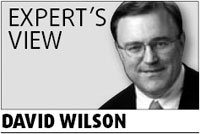Is 2008 becoming another 1938?
Anyone trying to make sense out of the day-to-day swings in US stocks this year has to look back seven decades for a precedent. The earlier performance ought to hearten those anticipating a rally later this year.
Tuesday marked the 62nd day of trading this year on US stock exchanges - and the 32nd time that the Standard & Poor's 500 Index rose or dropped more than 1 percent, according to data compiled by Bloomberg.
The last full year with more frequent moves of this magnitude was 1938, when 57 percent of daily changes in the index's value exceeded the threshold, S&P calculations show. This year's figure works out to 52 percent.

Look at what happened 70 years ago on a quarter-by-quarter basis, and the results may justify buying stocks. For one thing, the proliferation of 1 percent-plus swings wasn't a one-quarter phenomenon. First-, second- and third-quarter readings all were above 60 percent of trading days, based on Bloomberg's data.
For another, losses of this size outnumbered gains only in the first quarter, when they came out ahead by a 3-to-2 margin. The three-month period also was the only one that year in which the S&P 500 fell.
The 19 percent loss for the quarter was made up and then some in the next three months, when 1 percent-plus rallies beat comparable declines by about a 4-to-3 count. The S&P 500 soared 36 percent. During the third quarter, winners were comfortably ahead by about 5-to-4 and the index added 5.9 percent.
Put this together with the year's final quarter, in which stocks climbed as volatility lessened, and the S&P 500 racked up a 25 percent gain. That was almost identical to the index's best annual performance of the past decade: a 26 percent increase in 2003, the first full year of the latest US bull market.
The 3.6 percent jump in the S&P 500 on Tuesday is a step toward a similar turnaround. As first-quarter earnings reports arrive during the next few weeks, it will become easier to see whether 2008 looks like 1938 revisited.
Bloomsbury Publishing Plc, which published the Harry Potter books in the United Kingdom, had far less to fall back on after the series ended last year than Scholastic Inc, its US counterpart.
Even so, Bloomsbury is off to a better start in the post-Potter era. Here's how the London-based company started out its earnings release on Tuesday: "2007 was an exceptionally strong year for the company and this momentum has continued into the first quarter of 2008."
Scholastic wasn't so effusive last week in reporting fiscal third-quarter results, and with good reason. The company, based in New York, recorded a wider loss even before writing down the value of a direct-sales unit. Scholastic also cut revenue and profit forecasts for the full year, ending in May.
The publishers' contrasting fortunes are evident in their stock performance. Bloomsbury has risen 43 percent since Nov 23, when the shares reached an eight-year low. Scholastic, which reached $40 a share on Oct 30 for only the second time since 2002, has dropped 22 percent since then.
David Wilson is a Bloomberg News columnist. The opinions expressed are his own.
(China Daily 04/03/2008 page17)














